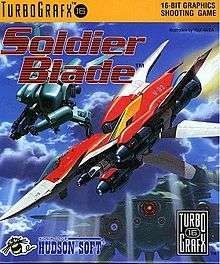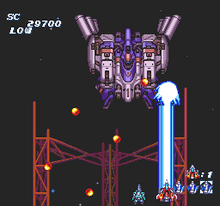Soldier Blade
Soldier Blade[lower-alpha 1] is a 1992 vertical-scrolling shooter video game developed and published by Hudson Soft for the TurboGrafx-16. Controlling the titular starship, the player is tasked with completing each of the game's seven stages in order to wipe out the Zeograd Army, an alien race bent on conquering Earth. Power capsules can be collected to give the Soldier Blade access to new weapons, and can even be destroyed to unleash a powerful screen-clearing superweapon. The game is the fourth entry in the Star Soldier series and shares many similarities with its predecessor Super Star Soldier, with Soldier Blade having a heavy emphasis on speed.
| Soldier Blade | |
|---|---|
 North American TurboGrafx-16 cover art | |
| Developer(s) | Hudson Soft |
| Publisher(s) | Hudson Soft |
| Designer(s) | Uriko Uribo |
| Series | Star Soldier |
| Platform(s) | TurboGrafx-16 |
| Release | |
| Genre(s) | Vertical-scrolling shooter |
| Mode(s) | Single-player |
The initial idea for Soldier Blade came from Hudson designer Uriko Uribo's conversations with other employees over which game to use for the company's upcoming Caravan video game tournament. With the event only six months away, Uribo was hesitant to begin production, however executives from Hudson pushed for him to go forward with the idea. Uribo was simultaneously working on several Game Boy games when development began, giving him less time to focus on the project until these games were completed. The game was originally titled Sonic Blaster F-92, which was changed to Soldier Blade due to trademark issues with another developer. Miscommunication between Uribo and staff lead to several mechanics being altered or changed by mistake, such as several stronger enemies instead being easy to kill. Time and hardware constraints added pressure to the team, leading to several ideas being heavily modified or scrapped entirely. It began development on a 6-megabit HuCard, reduced to a 4-megabit one later on.
Although the game was rushed to meet its deadline, Soldier Blade was liked by critics for its gameplay, visuals and power-up system, though some thought it lacked originality and felt inferior to Hudson's previous shooters for the system, namely Blazing Lazers and Final Soldier. Retrospective reviews were much more positive, with some labeling it one of the TurboGrafx-16's definitive shooter games for its fast-paced gameplay and easy learning curve. It was re-released on the Wii Virtual Console as a digital download in 2007, and included on the PlayStation Portable compilation Soldier Collection. A PlayStation Network version was released in 2009, followed by a Wii U Virtual Console re-release in 2014.
Gameplay

Soldier Blade is a vertical-scrolling shooter video game, and the fourth in Hudson's successful Star Soldier series. The player assumes the role of the titular starship, which must complete each of the game's seven stages (referred to as "operations" in-game) in an effort to wipe out the Zeograd Army, an alien race bent on conquering Earth.[1] Gameplay is often compared to its predecessor Super Star Soldier, sharing many of its gameplay elements and mechanics, however with a heavy emphasis on speed.[2][3]
The Soldier Blade begins the game with a standard "Vulcan" projectile, which can destroy most enemies with a single shot, and can collect other weapons by acquiring different colored power capsules; these include a wave gun and a deadly laser that wipes out anything in its path.[1] Collecting a power capsule will also cause a pod-like craft to join the player, which provides additional firepower.[1] The Soldier Blade can be destroyed by colliding with either an enemy or a projectile; by collecting up to three power capsules, the player can take up to three hits.[1] The player can also store three power-up items in a storage box placed towards the bottom of the screen, which can be deployed at any time.[1] Weapons can also be destroyed to give the player a devastating screen-clearing superweapon, which can wipe out all enemies on the screen.[1] A miniboss will need to be fought towards the middle of the stage, followed by an actual boss at the end.[4] Bosses can be destroyed by shooting at its weak point.[1]
Akin to other games in the series, Soldier Blade has two "Caravan" time attack modes, a two-minute version and a five-minute version.[4][1] In both of these, the player is tasked with scoring as many points before the time runs out.[1] Completing the main game will give the player access to a stage select, allowing them to play whichever area they choose.[1]
Development

The initial idea for Soldier Blade was conceived by Hudson Soft designer Ukiuki Uribo, during conversations with others about which game to use for the company's upcoming Caravan video game tournament.[5] Hikaru Aoyama suggested creating a new shooting game with the tournament in mind; Uribo was hesitant to begin working on it due to it being around six months away, however Hudson executives pushed for the idea to go forth anyway.[5] During early stages of production Uribo was simultaneously working on several Game Boy titles, which gave him less time to focus on the new game until these were completed.[5] Planning for the project was known to be constantly under pressure via time and memory constraints, with employees simply throwing in ideas on the spot and creating the game as they went.[5] It was originally called Sonic Blaster F-92 in early versions, named after the player's ship designed by artist Tatsuya Doe, however trademark issues caused it to be renamed Soldier Blade instead.[5] It began development on a 6-megabit HuCard, reduced to a 4-megabit one later on.[5]
Uribo originally wanted enemy sprites to have more diversity and variety, which due to memory limitations had to be cut.[5] Miscommunication between Uribo and the rest of the development team within the planning documents caused some elements of the game to be altered by mistake, such as the large "Bay Wolf" battleships in the first stage being near-defenseless and easy kills and the "missile pod" enemies in the sixth stage to fire a simple spread shot instead of homing missiles.[5] The development team were interested in including an asteroid belt stage with diagonal scrolling and enemies using the asteroids as shields, however time and hardware constraints forced it to be scrapped.[5] Uribo composed much of the music himself, with composers Masaaki Inoue and designer "S-guchi-san" doing the rest.[5] Per Uribo's request, Keita Hoshi created a medley theme featuring music from each stage of the game to be played at the end credits.[5] Atsushi Kakutani designed the Caravan Mode almost entirely alone, although Uribo provided some minor assistance.[5] The cover art was created by Yuji Kaida, a famed Japanese illustrator known for producing art for series such as Godzilla, Ultraman and Macross.[5]
Release
Soldier Blade was released for the PC Engine in Japan on July 10, 1992.[6] It was released in North America for the TurboGrafx-16 two months later in September.[7] Uribo wished that he and the development team had more time to correct and refine many of its mechanics and features, however time constraints forced them to release it in its current stage.[5] After its release Uribo began drafts for a potential Soldier Blade II, an idea that was never fulfilled.[5] For their Caravan tournament, Hudson produced a modified version of the game called Soldier Blade Special Version, which only features the two Caravan time attack modes.[8] It was produced in very limited quantities, and typically commands high prices on online auction sites.[8]
Soldier Blade was digitally re-released for the Wii Virtual Console in North America on January 8, 2007, in Europe on January 26, 2007, and in Japan on January 30, 2007.[4] It is included in the 2008 PlayStation Portable compilation Soldier Collection alongside its predecessors Super Star Soldier, Final Soldier and Star Parodier.[9] It was re-released for the PlayStation Network service on February 17, 2010 in Japan under the Game Archives brand.[10] A digital version for the Wii U Virtual Console was released in 2014.[11]
Reception
| Reception | ||||||||||||||||||||||
|---|---|---|---|---|---|---|---|---|---|---|---|---|---|---|---|---|---|---|---|---|---|---|
| ||||||||||||||||||||||
The original TurboGrafx-16 version of Soldier Blade was met with a mixed response from critics. GameFan compared the game favorably to Hudson's own Blazing Lazers,[13] while Famitsu said it was one of the better shooters released for the console.[6] Electronic Gaming Monthly labeled it "a hastily crafted title to herald the soon-to-be-released TurboDuo."[3] Several were mixed on the gameplay, with Electronic Gaming Monthly finding it average and GameFan greatly applauding it for its originality and fast-paced action.[3][13] Famitsu said that while the gameplay was enjoyable, it was not as refined as Hudson's earlier shooters for the systems.[6] Player One magazine found it not well-designed and too easy, feeling it was disappointing compared to Final Soldier.[16] Many praised the graphics for being detailed and colorful,[3][14][13][6] with Player One adding that was one of the game's defining features.[16]
The Wii Virtual Console version garnered a more positive response. Eurogamer said it was "twitch gaming in its purest, most basic form",[12] while Nintendo Life called it "one of the most respected games for the system".[4] IGN found it to be an excellent addition to the Wii Virtual Console library, saying that it stuck out from most shooters available for the service.[2] The gameplay itself was praised by many, with GameSpot applauding its easy learning curve and IGN liking its fast pace, saying it had some of the best on the TurboGrafx-16 as a whole.[15][2] Eurogamer claimed it to be the fastest shooter on the system and for its gameplay being "surprisingly easy".[12] Several praised the game's graphics, visual effects and soundtrack. Nintendo Life said that it added a "timeless quality" to it,[4] with GameSpot and IGN commending the graphics for being colorful and detailed.[15][2] GameSpot also liked the game's visual effects for being impressive and well-made.[15] Many publications greatly appreciated the power-up system for being unique and fun to use,[4][2] with GameSpot in particular liking its flexibility and for being easy to understand.[15]
Notes
References
- Soldier Blade instruction manual (PDF) (in Japanese). Japan: Hudson Soft. 10 July 1992. Archived from the original (PDF) on 5 January 2017. Retrieved 7 December 2019.
- Bozon, Mark (22 February 2007). "Soldier Blade VC Review". IGN. Archived from the original on 3 May 2019. Retrieved 7 December 2019.
- Harris, Steve; Semrad, Ed; Alessi, Martin; Sushi-X (October 1992). "Review Crew" (39). EGM Media, LLC. Electronic Gaming Monthly. p. 32. Retrieved 7 December 2019.
- Nintendo Life Staff (9 January 2007). "Soldier Blade Review (TG-16)". Nintendo Life. Archived from the original on 9 May 2019. Retrieved 7 December 2019.
- Uribo, Ukiuki (2012). "Soldier Blade – 2012 Developer Interview". Shmuplations. Archived from the original on 25 October 2018. Retrieved 7 December 2019.
- "ソルジャーブレイド [PCエンジン] / ファミ通.com". www.famitsu.com. Retrieved 2018-10-26.
- "Soldier Blade" (38). EGM Media, LLC. Electronic Gaming Monthly. September 1992. pp. 154–155. Retrieved 7 December 2019.
- "【宅配買取】PCエンジン キャラバン公認ソフト スペシャルバージョンを東京都江戸川区のお客様よりお譲りいただきました". BEEP!. 14 March 2017. Archived from the original on 6 July 2017. Retrieved 7 December 2019.
- North, Dale (29 June 2008). "Pew-Pew-PSP collection of Star Soldier games might be on the way". Destructoid. Archived from the original on 17 March 2010. Retrieved 7 December 2019.
- "ソルジャーブレイド". Official PlayStation Store Japan. SIE Worldwide Studios. Archived from the original on 26 April 2016. Retrieved 18 December 2019.
- "Soldier Blade". Nintendo World Report.
- Parkin, Simon (23 June 2007). "Virtual Console Roundup". Eurogamer. p. 4. Archived from the original on 4 June 2017. Retrieved 7 December 2019.
- Skid; Brody (December 1992). "Viewpoint - Soldier Blade" (Volume 1, Issue 2). DieHard Gamers Club. GameFan. p. 9. Retrieved 7 December 2019.
- Speedy Buns (October 1992). "TurboGrafx-16 Pro Review - Soldier Blade" (39). International Data Group. GamePro. p. 100. Retrieved 7 December 2019.
- Provo, Frank (8 February 2007). "Soldier Blade Review". GameSpot. Archived from the original on 7 December 2019. Retrieved 7 December 2019.
- Chris (September 1992). "Soldier Blade" (in French) (23). Player One. p. 120. Archived from the original on 7 December 2019. Retrieved 7 December 2019.